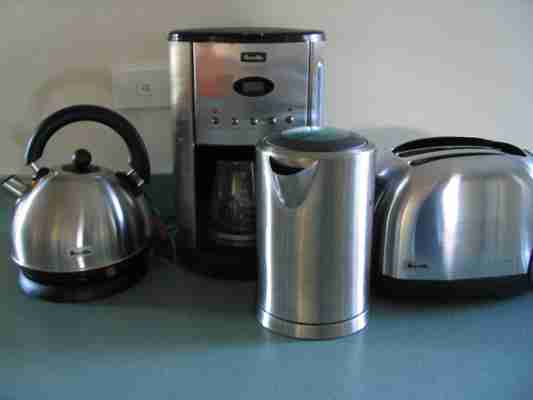Appliances are technologies that run off of electricity or natural gas, used within a residence to accomplish various household needs. Appliances do not include space heating, cooling, or lighting systems, but make up nearly all others. Examples of appliances include refrigerators, microwaves, washers, dryers, and toasters.

The reliance on appliances in recent decades has increased their frequency of use, resulting in a higher portion of residential energy use. In Canada, space heating makes up the vast majority of home energy use followed by domestic water heating, with appliance use taking around 13%.[2]
In the U.S., appliances account for about 35% of total household energy consumption, while domestic water heating, space heating and air conditioning makes up the rest.[3] This is up from 24% in the mid 1990's.
Appliance energy use
Although the energy efficiency of many appliances like refrigerators and computers have increased drastically since the 20th century, there are typically more of them in a given household which offsets this efficiency gain.[3] More than 76% of households in the United States have at least one computer and it is also more common to have multiple television sets within a house, with nearly half of all homes containing over three.[4]
The use of electronic appliances has increased as well, surpassing natural gas appliances.[3] This is troublesome because around 3 units of primary energy is required to generate 1 unit of electricity in a typical power plant, such as a coal-fired power plant.[4] So although these electronic appliances are as efficient as natural gas appliances in their use of energy, it is somewhat deceiving. It is recommended to choose natural gas over electronic appliances when possible because of this.[5]
Energy use by appliance type (Canada)
The breakdown of energy use by appliance, as a percentage of total household appliance use, are as follows (2012):[6]
Clothes dryer - 18.6%
- 18.6% Range (oven/stove) - 17.3%
- 17.3% Refrigerator - 15.4%
- 15.4% Freezer - 5.0%
- 5.0% Dishwasher - 1.5%
- 1.5% Clothes washer - 1.5%
- 1.5% Other appliances (TVs, computers and microwaves) - 40.8%
Energy.gov has put together an appliance energy calculator: To calculate your personal appliance energy use, click here!
Embodied energy
Aside from energy consumption during an appliance's operation, appliances also require tremendous amounts of energy to create. Their materials must be mined and shaped, their components manufactured and assembled, and the final product transported. The energy that goes into a given object is known as its embodied energy, since it is the energy "embodied" within the object itself. The embodied energy of several appliances is listed in the table below, measured in megajoules (1 million joules) per functioning unit.
Item Embodied energy (MJ/functional unit)[7][8] Hair dryer 79 Coffee maker 184 LCD monitor 963 Smartphone 1,000 PC tower 2,085 Washing machine 3,900 Laptop 4,500 Refrigerator 5,900 Digital copier 7,924
The tremendous amount of energy needed to make such objects, means a great deal of resources can be saved by recycling these appliances at the end of their lifetime. The energy required to reprocess the materials and then create a new appliance is much less than it is to mine, transport and create an entirely new one. There are often recycling programs for these which can be looked up online.
Appliance purchasing tips
Purchasing an energy efficient appliance might seem costly upfront, but in the long run they can save a person money, along with having a reduced environmental impact. One major recommendation is to look for the Energy Star label (Figure 2) which is indicative of an extremely energy efficient product, surpassing requirements set by federal governments.[5] For a detailed guide on purchasing an appliance, visit NRDC which gives information on refrigerators, washers and dryers, air conditioners, and more.
References
